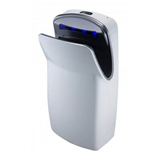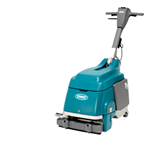Looking to buy a ride-on scrubber dryer in Australia? This complete guide covers pricing, key features, operating costs, compliance, and how to pick the right model for your needs.
Key takeaways
- Price range: Ride on scrubber dryers in Australia cost between $15,000 and $60,000, depending on size, battery type, and features.
- Types: Battery-powered models dominate, with options for lithium-ion or lead-acid batteries influencing price and run time.
- Operational efficiency: These machines can clean up to 4,000 m² per hour, boosting productivity and reducing labour costs by up to 50% compared to manual cleaning.
- Maintenance: Routine checks on brushes, squeegees, and batteries extend machine life beyond 7 years.
- Financing: Equipment financing options are widely available, with interest rates averaging 6.5%–10% over 3–5 years.
- Compliance: Australian buyers must ensure machines meet Australian Standards AS/NZS 60335 and workplace safety regulations under Safe Work Australia.
Introduction
For Australian businesses managing large commercial or industrial spaces, investing in a ride on scrubber dryer is a smart decision that improves cleaning efficiency, hygiene standards, and operational productivity. Whether you operate a warehouse, shopping centre, hospital, or educational facility, understanding the price landscape, types, operation, and compliance requirements for ride on scrubber dryers will help you make an informed purchase.
This guide delivers a detailed overview of ride on scrubber dryer prices in Australia for 2025, explores different machine types, and offers actionable insights on maintenance, parts, financing, and warranties. It also answers common buyer questions to ensure your investment fits your operational needs.
Types of Ride on Scrubber Dryers
Australian buyers typically encounter three main types:
- Battery-powered scrubber dryers: The most popular choice, offering 2–4 hours of continuous run time depending on battery type.
- Lithium-ion batteries are pricier but offer faster charging and longer lifespan (up to 1,000 cycles).
- Lead-acid batteries are more affordable upfront but require longer charging and maintenance.
- Corded electric models: Less common for ride-ons due to mobility limitations but used in some large fixed facilities. Typically cheaper but restrict movement.
- Hybrid models: Combine battery power with a small onboard generator, ideal for sites requiring longer runtimes without recharging downtime.
Ride on Scrubber Dryer Prices in Australia
Pricing varies significantly based on machine size, battery technology, and feature set:
- Compact models (ideal for small to medium facilities): $15,000 to $30,000
- Mid-range models (suitable for large retail, warehouses): $30,000 to $45,000
- Heavy-duty industrial models (for large-scale, high-frequency use): $45,000 to $60,000+
Used or refurbished machines can cost 30–50% less but carry risks around battery health and wear parts.
Operation and Efficiency
- Typical ride on scrubber dryers clean an area of 3,000 to 4,000 m² per hour, compared to manual mopping which averages 1,000 m² per hour.
- Operating one machine can reduce labour costs by up to 50%, making it highly cost-effective for large facilities.
- Advanced models include features like automatic water dosing, adjustable brush pressure, and eco modes for energy and water savings.
Maintenance and Parts
Regular maintenance prolongs machine life and performance:
- Daily: Clean squeegee blades, empty recovery tanks, inspect brushes.
- Weekly: Check battery charge levels and water tanks.
- Monthly: Inspect drive systems, replace worn brushes or squeegees as needed.
- Battery care: Lithium-ion batteries require less maintenance than lead-acid but still need periodic checks.
Typical maintenance costs average $1,000 to $2,500 annually depending on usage and model.
Financing Options
Australian businesses can leverage various financing options for ride on scrubber dryers:
- Chattel mortgages: Interest rates range from 6.5% to 9.5% over 3–7 years with tax benefits via GST credits and depreciation.
- Finance leases: Interest rates typically range from 7% to 11% for 3–5 years, with lease expenses claimable as tax deductions.
- Equipment loans: Available from specialist lenders and banks, often with flexible terms tailored to business cash flow.
To explore flexible, fast, and competitive financing tailored for ride on scrubber dryer, check out Easy Asset Finance. Their expert team can help you secure the best terms to preserve your cash flow and grow your business.
Warranties and Support
- Most new ride on scrubber dryers come with a 12 to 24-month manufacturer warranty covering parts and labour.
- Extended warranty and service plans are common and recommended to reduce unexpected repair costs.
- Support availability is critical: ensure your supplier offers local service centres and genuine spare parts to reduce downtime.
Compliance and Certification for Australian Buyers
- Machines must comply with Australian/New Zealand Standard AS/NZS 60335 on safety for electrical appliances.
- Ensure compliance with Safe Work Australia’s guidelines for machinery use in workplaces, including operator training and risk assessments.
- Check for electromagnetic compatibility (EMC) certification to prevent interference with other devices.
- Battery disposal and recycling must meet Australian environmental regulations.
Fit-out and site-readiness tips
Before purchasing a ride-on scrubber dryer, it's essential to ensure your facility is physically prepared for its effective use. Overlooking site-readiness can lead to costly delays, machine underperformance, or even damage. Here's what to check:
- Access clearance: Measure all doorways, ramps, and lifts to confirm they accommodate the full height, width, and turning radius of your chosen machine. Many commercial models range from 900mm to 1,200mm wide, so tight corridors and lift entries can be problematic.
- Charging station setup: If you're buying a battery-powered model (the most common type in Australia), designate a well-ventilated, dry area for charging. It should include a dedicated power outlet, be free of flammable materials, and comply with AS/NZS 3000 electrical standards.
- Floor type and condition: Choose brush types and water pressure settings that suit your flooring material. For example:
- Soft brushes are ideal for epoxy-coated or vinyl floors.
- Stiff brushes or abrasive pads suit concrete or textured surfaces.
- Squeegee quality also matters—worn squeegees can leave streaks or water behind on uneven floors.
- Slope and gradient checks: Confirm whether your facility has ramps, gradients, or dock inclines. Many ride-on units are rated up to 10% (5.7°) slope when fully loaded—exceeding this can reduce safety and cleaning performance.
Common Questions from Buyers
Q: What is the typical lifespan of a ride on scrubber dryer?
With proper maintenance, machines last 7 to 10 years in commercial settings.
Q: Are lithium-ion batteries worth the extra cost?
Yes, lithium-ion batteries reduce charging time by up to 50% and typically last twice as long as lead-acid, saving money in the long term.
Q: Can ride on scrubber dryers be used on all floor types?
Most models are suited to sealed concrete, tile, and vinyl floors. Some have adjustable brush pressure for delicate surfaces.
Q: How much area can a ride on scrubber dryer clean in an hour?
On average, between 3,000 to 4,000 m² per hour, depending on model and settings.
Conclusion
Investing in a ride on scrubber dryer is a strategic move for Australian businesses looking to enhance cleaning efficiency and workplace safety. Understanding the price ranges, machine types, operational benefits, and compliance requirements ensures you select a machine that meets your budget and operational needs.
Whether you opt for a compact battery-powered model or a heavy-duty industrial machine, prioritising supplier reliability, maintenance planning, and financing options will maximise your investment's value and longevity.






-160x160-state_article-rel-cat.png)







